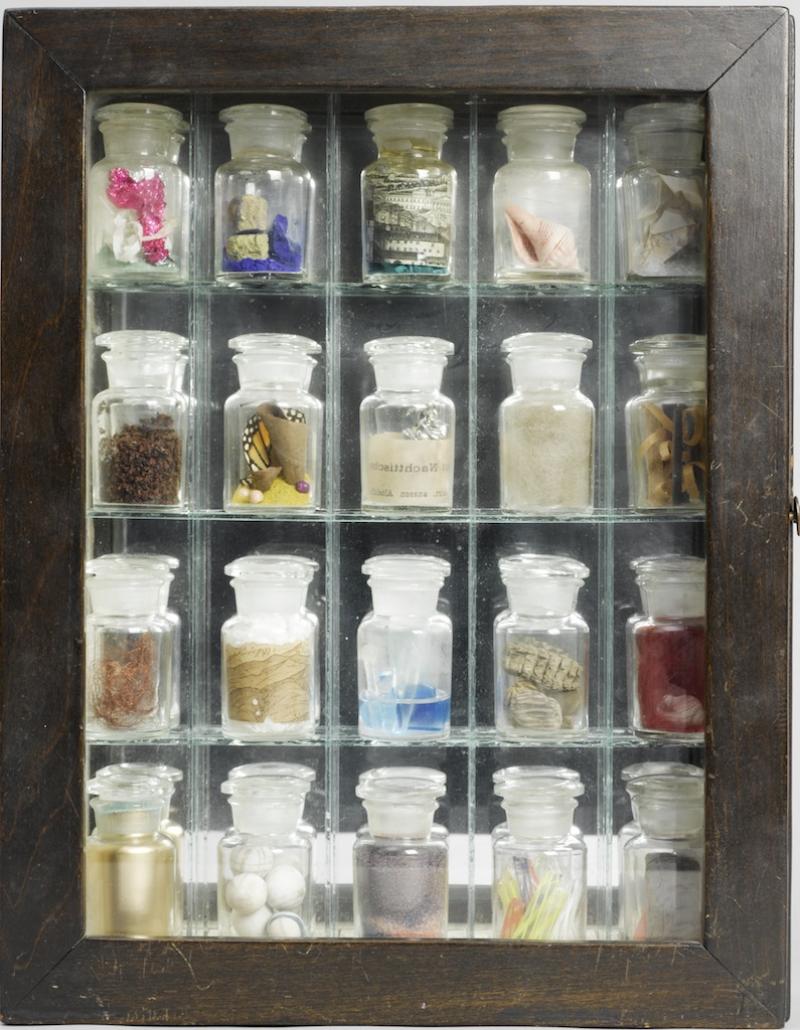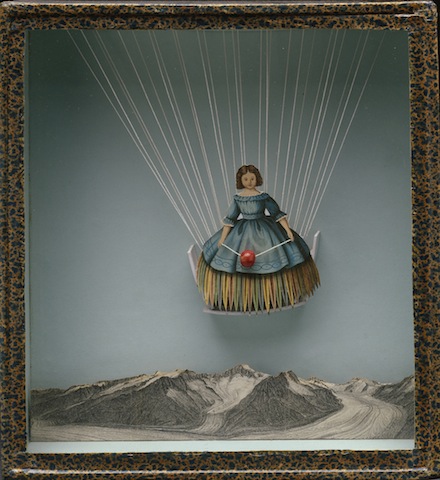Joseph Cornell: Wanderlust, Royal Academy | reviews, news & interviews
Joseph Cornell: Wanderlust, Royal Academy
Joseph Cornell: Wanderlust, Royal Academy
The beguiling tone poems of an American artist

Whimsical, twee, sentimental. For those who love Joseph Cornell’s boxes, it’s hard to imagine that there are those who just don’t. “What? You mean you don’t like Cornell’s boxes because you think they’re whimsical? Twee? Sentimental?”
These rare people include one or two art critics I’ve known, and the incredulous reaction is my own. But he could be all of those things, of course; and as Robert Hughes reminded us on the occasion of Cornell’s 1980 survey at the Museum of Modern Art, New York, “There is a treacherous line between sentiment and sentimentality, particularly in [Cornell’s] evocations of his Edwardian childhood.”
In the Royal Academy’s survey that treacherous line only occasionally comes into focus. A cut-out girl (pictured below), serene, weightless, borne up on white cotton threads as she daintily floats over the Alps in crinoline that echoes the shape of a hot-air balloon, is surely one such piece that skirts that line and wobbles. The work was made in homage to the dancer Tilly Losch, one of several of the artist’s pashes on ballerinas and stage starlets. And often these are the least successful of his works.
Still, it’s an exquisite eye for form and juxtaposition that steers us clear on the whole, and even when it doesn’t there’s nothing cloying about it. This is sentimentality that isn’t heavily perfumed. It scents the air; it won’t choke you.
And what of the much talked of absence of sex that Hughes also drew our attention to, despite all those evocations of the divine, the sensual but untouchable, female? Cast your eye back to the balloon girl, and the cherry red bead dangling by a string between her fingers. Does it hint at the thrillingly Freudian? The darkly suggestive? Sex and surrealism went hand in hand for European artists such as Duchamp and Max Ernst, the murky, subterranean passions of the unconscious the meat and drink of that movement, to which Cornell was attached through friendship and influence.
 And yet Cornell seems decidedly pre-sex, not in the sense of its complete absence, but in its fragile burgeoning, in its on the cuspness, its lack of maturity. Neither absent nor repressed, the hints of sex to be found in Cornell’s juxtapositions, as well as in his obsessive romantic longings at far remove, present a state of perpetual pre-adolescence.
And yet Cornell seems decidedly pre-sex, not in the sense of its complete absence, but in its fragile burgeoning, in its on the cuspness, its lack of maturity. Neither absent nor repressed, the hints of sex to be found in Cornell’s juxtapositions, as well as in his obsessive romantic longings at far remove, present a state of perpetual pre-adolescence.
Cornell’s biography is well enough known not to recount it at length here. Suffice to say, here is an artist who wandered the cosmopolitan centres of Europe – encountering a refined fairyland – in his mind, but who’d travelled no further than Maine, and had apparently never spent a night away from home. He was not an outsider in the sense that he genuinely stood outside the art world, for he had many an acquaintance within it and a high-profile New York gallery to represent him. But in a very real sense he still stood outside it – emotionally rather than artistically dislocated. However, he also had a sophisticated insider’s insight into his work, once writing that he wasn’t interested in expressing the “black magic” of the Surrealists, but in cultivating “white magic”.
The best pieces are the cabinets of repeated motifs: the white grids of his “Dovecoates” series, with their sequence of balls or wooden cubes; and his “Medici” series, where we find a tiny inky portrait, times 20, by a follower of Caravaggio, accompanied by 20 inky balls. The inky balls somewhat suggest the perfect, pared-down Mannerist head of the subject, which in turn resembles an egg in its shell. One thinks also of Koons’ weird couplings of blue balls and classical statuary and Warhol’s repeated inky screenprints. The Pharmacy cabinets, too (see main picture), with their vials of coloured pigments, shells, butterfly wings, which predate Damien Hirst by five decades. None, however, express the lyrical "tone poetry" of Cornell.
What speaks powerfully is a psychological dimension to the work. It would be odd not to note this, for that strange sense of dislocation and arrested development feel so present.
Explore topics
Share this article
Add comment
The future of Arts Journalism
You can stop theartsdesk.com closing!
We urgently need financing to survive. Our fundraising drive has thus far raised £49,000 but we need to reach £100,000 or we will be forced to close. Please contribute here: https://gofund.me/c3f6033d
And if you can forward this information to anyone who might assist, we’d be grateful.

Subscribe to theartsdesk.com
Thank you for continuing to read our work on theartsdesk.com. For unlimited access to every article in its entirety, including our archive of more than 15,000 pieces, we're asking for £5 per month or £40 per year. We feel it's a very good deal, and hope you do too.
To take a subscription now simply click here.
And if you're looking for that extra gift for a friend or family member, why not treat them to a theartsdesk.com gift subscription?
more Visual arts
 'We are bowled over!' Thank you for your messages of love and support
Much-appreciated words of commendation from readers and the cultural community
'We are bowled over!' Thank you for your messages of love and support
Much-appreciated words of commendation from readers and the cultural community
 Folkestone Triennial 2025 - landscape, seascape, art lovers' escape
Locally rooted festival brings home many but not all global concerns
Folkestone Triennial 2025 - landscape, seascape, art lovers' escape
Locally rooted festival brings home many but not all global concerns
 Sir Brian Clarke (1953-2025) - a personal tribute
Remembering an artist with a gift for the transcendent
Sir Brian Clarke (1953-2025) - a personal tribute
Remembering an artist with a gift for the transcendent
 Emily Kam Kngwarray, Tate Modern review - glimpses of another world
Pictures that are an affirmation of belonging
Emily Kam Kngwarray, Tate Modern review - glimpses of another world
Pictures that are an affirmation of belonging
 Kiefer / Van Gogh, Royal Academy review - a pairing of opposites
Small scale intensity meets large scale melodrama
Kiefer / Van Gogh, Royal Academy review - a pairing of opposites
Small scale intensity meets large scale melodrama
 Jenny Saville: The Anatomy of Painting, National Portrait Gallery review - a protégé losing her way
A brilliant painter in search of a worthwhile subject
Jenny Saville: The Anatomy of Painting, National Portrait Gallery review - a protégé losing her way
A brilliant painter in search of a worthwhile subject
 Abstract Erotic, Courtauld Gallery review - sculpture that is sensuous, funny and subversive
Testing the boundaries of good taste, and winning
Abstract Erotic, Courtauld Gallery review - sculpture that is sensuous, funny and subversive
Testing the boundaries of good taste, and winning
 Edward Burra, Tate Britain review - watercolour made mainstream
Social satire with a nasty bite
Edward Burra, Tate Britain review - watercolour made mainstream
Social satire with a nasty bite
 Ithell Colquhoun, Tate Britain review - revelations of a weird and wonderful world
Emanations from the unconscious
Ithell Colquhoun, Tate Britain review - revelations of a weird and wonderful world
Emanations from the unconscious
 Rachel Jones: Gated Canyons, Dulwich Picture Gallery review - teeth with a real bite
Mouths have never looked so good
Rachel Jones: Gated Canyons, Dulwich Picture Gallery review - teeth with a real bite
Mouths have never looked so good
 Yoshitomo Nara, Hayward Gallery review - sickeningly cute kids
How to make millions out of kitsch
Yoshitomo Nara, Hayward Gallery review - sickeningly cute kids
How to make millions out of kitsch
 Hamad Butt: Apprehensions, Whitechapel Gallery review - cool, calm and potentially lethal
The YBA who didn’t have time to become a household name
Hamad Butt: Apprehensions, Whitechapel Gallery review - cool, calm and potentially lethal
The YBA who didn’t have time to become a household name

Comments
What is a tone poem? This
Actually it's a subtle and
Dear Me, why don't you look
Dear Me, why don't you look up 'tone poem' in a dictionary? Google - I use it all the time - is also helpful for words/terms that are new to you. As for my conclusion - I believe there was a lot in the piece that pretty much covered it tbh. But thanks for your comments. I'm glad you enjoyed other reviews.